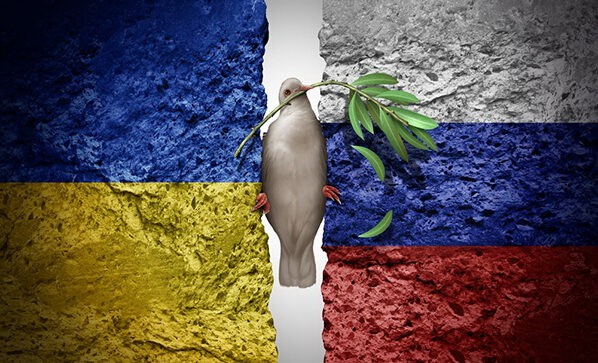Ukraine is staring down the barrel of a brutal reality check. Eight years ago, the warning signs were there—America’s foreign policy isn’t set in stone, and D.C. can flip the script anytime. But Kyiv’s leadership, high on the fantasy of unconditional Western backing, slammed the door on any compromise with Moscow, betting it all on military victory. Fast forward to today: Ukraine is in ruins, its army is bleeding out, millions have fled, and even the country’s sovereignty is up in the air.
But here’s the kicker—Ukraine isn’t running the show. It’s a pawn in a game played by much bigger powers. U.S. priorities are shifting, and now, with Donald Trump ready to shake up the board and Europe showing serious war fatigue, Kyiv is looking at the possibility of being left high and dry. If Ukrainian diplomacy doesn’t snap out of its dreamland and start pushing for a real, hard-nosed deal, the price of its miscalculations will only skyrocket.
Through the smoke of obliterated cities and endless trench warfare, one path to peace is coming into focus—Ukraine’s neutrality. Like it or not, it’s the only realistic option on the table. The question isn’t whether it happens, but how it happens: Does Kyiv get steamrolled into a weak, dictated settlement that costs it half its land, or does it negotiate a smart, balanced deal that guarantees security without total surrender?
Moscow has made its terms clear—neutral Ukraine or no deal. If Kyiv commits to that, Russia might be willing to meet halfway. But neutrality can’t be a blank check for Russia—it has to come with ironclad security guarantees from the U.S. and the West. If Russian troops cross the line again, a multinational coalition needs to hit back, no hesitation. That’s a tougher deterrent than even NATO’s Article 5. And the best part? It keeps Ukraine out of the alliance, which is exactly what the Kremlin has been freaking out about.
But here’s the elephant in the room: Will Russia agree to hand back the occupied territories in return for neutrality? If Putin refuses, he needs to understand one thing—Ukraine will never recognize the loss of its land, and as long as that issue stays unresolved, Moscow will stay locked in an economic and diplomatic chokehold.
If the Kremlin digs in its heels, the White House and global heavyweights need to make the stakes crystal clear—dragging out this war means economic freefall, continued battlefield losses, and deepening international isolation. Putin learned the hard way in 2022 that quick victories are a pipe dream, and he knows Russia isn’t built for an endless war of attrition.
At some point, the Kremlin has to choose: freeze the conflict and live with permanent uncertainty, or cut a deal and start digging out of the hole it’s in.
China is the wildcard here. Beijing has already played both sides, saying it respects Ukraine’s sovereignty while nodding to Moscow’s NATO paranoia. But if China backs a neutrality deal that restores Ukraine’s pre-2022 borders, Russia would find it damn hard to say no. And if India, Brazil, and South Africa get on board too, that’s a whole new level of pressure.
No More Fairy Tales—It’s Decision Time
Kyiv can keep dreaming about some miraculous military turnaround. But the cold, hard facts say otherwise:
The army is running on fumes—casualties are sky-high, recruitment is scraping the bottom of the barrel, and the West’s weapons pipeline is slowing down. Washington’s patience is wearing thin—Trump or not, D.C. won’t bankroll Ukraine forever. The economy is toast—Ukraine is surviving on life support from foreign cash, and that won’t last. Russia is playing the long game—sanctions hurt, but Moscow isn’t collapsing. A never-ending war means a dead-end future—Ukraine risks losing everything if it keeps fighting a battle it can’t win.
Trump’s return to power could be Ukraine’s only real shot at a settlement. Whether Kyiv likes him or not, he’s the one guy who might actually have the leverage to force a deal that keeps Ukraine alive.
The fantasy of total victory needs to go. The only way Ukraine survives is by playing the cards it has right now, not the ones it wishes it had.
Kyiv can either face reality and negotiate from a position of strength, or wait until there’s nothing left to bargain with. The choice is theirs.
Even if a peace deal is struck, Ukraine faces an uphill battle for survival. Millions of Ukrainians won’t return to a country still on the edge of war. Foreign investors won’t gamble on an economy that has no clear path to stability.
The harsh truth? Even in the best-case scenario, it will take decades for Ukraine to rebuild. The country needs deep, painful reforms—from purging corruption to restructuring its entire administrative system. The political class, drunk on empty slogans, must finally wake up to reality: the West won’t foot the bill forever. Ukraine has to learn to stand on its own two feet.
But before Kyiv can even think about the future, it needs to focus on one thing—survival. And that means letting go of illusions, accepting that neither NATO nor the EU will save it, and making the only rational choice left.
War teaches cruel lessons. For Ukraine, that lesson is simple: take the deal that’s still on the table, not the fantasy that will never come true. This is the last real shot at survival.
Kyiv’s Military Strategy Is in Freefall: The Hard Numbers
1. Military Collapse & Manpower Crisis
- Ukraine has lost around 20% of its territory, with no sign of a breakthrough on the horizon.
- Western intelligence estimates 350,000+ Ukrainian troops killed or wounded, and the manpower reserves are running dry.
- Kyiv is now drafting men over 60 and disabled citizens, a desperate move signaling a full-blown recruitment crisis.
- Meanwhile, Russia has ramped up its arms production 5X compared to 2021, cranking out more shells per month than the U.S. and Europe supply Ukraine in half a year.
2. Economic Freefall
- Ukraine’s GDP has shrunk by 30%, and the country is 100% reliant on Western cash infusions to stay afloat.
- The 2024 budget deficit is projected at $43 billion, meaning Ukraine can’t even pay government salaries or pensions without international loans.
- Over 80% of Ukraine’s energy infrastructure has been crippled by Russian strikes, with no clear path to full recovery.
- Exports have plummeted by over 50%, and the loss of access to the Black Sea has shattered Ukraine’s ability to function as a trading economy.
3. Western Fatigue Is Real
- Calls to cut military aid and push for negotiations are getting louder in European capitals.
- Donald Trump has already made it clear—he won’t keep writing blank checks unless Ukraine makes a deal.
- Germany and France are quietly signaling that their support isn’t endless, while Italian politicians are saying the quiet part out loud: “Ukraine can’t win.”
- NATO has walked back its promises of quick Ukrainian membership, raising questions about the entire purpose of continuing the war.
Given all this, a peace deal isn’t a betrayal—it’s Ukraine’s only shot at survival. The alternative is fighting to the last soldier and watching the country collapse entirely.
Many experts now argue that the best-case scenario for Kyiv is a neutral status backed by ironclad security guarantees. This would allow Ukraine to keep its remaining land, stop the economic bleeding, and prevent more bloodshed.
What Would Neutrality Look Like?
Officially abandoning NATO membership, but securing U.S.-led security guarantees that act as a de facto NATO shield. Russian troops withdrawing from occupied territories, on the condition that Ukraine doesn’t use them as staging grounds for a future war. UN peacekeeping forces deployed in disputed regions to prevent further flare-ups. Restoring limited trade with Russia to stabilize Ukraine’s battered economy. A military pivot to an Israeli-style defense model—a smaller, highly advanced military with direct U.S. backing and heavy deterrence measures.
The biggest question isn’t whether this deal is possible—it’s whether Ukraine’s leaders will take it or drive their country into total ruin out of sheer stubbornness.
Time is running out. If Ukraine plays its cards right, it can still walk away with something. If not, it risks losing everything.
Moscow’s Next Moves: What’s Russia’s Endgame?
Russia isn’t just sitting back—it’s playing the long game and adjusting its strategy accordingly. Moscow has learned the hard way that direct rule over occupied territories isn’t a strategic win—it’s a financial and logistical nightmare. Running DNR, LNR, Zaporizhzhia, and Kherson is draining billions, and while the Kremlin won’t admit it publicly, there’s a real cost-benefit debate happening behind closed doors. If Russia can secure a neutral Ukraine, it might be willing to cut a deal rather than keep bankrolling an endless occupation.
But if Kyiv refuses to negotiate? Russia will keep grinding away on the battlefield.
Moscow’s playbook has changed—this is now a war of attrition. And the math doesn’t favor Ukraine. The longer this drags on, the more Ukraine bleeds out—territory, troops, resources, and morale.
That said, Russia isn’t bulletproof either. The longer the war stretches, the higher the risks for Moscow:
- Sanctions aren’t crippling Russia, but they are slowing it down.
- Western military aid may be shrinking, but Ukraine is still getting enough to keep the fight going.
- A prolonged war keeps NATO on high alert and fuels European rearmament—something Moscow wanted to avoid.
So at some point, neutrality isn’t just a win for Kyiv—it’s a practical exit ramp for Moscow, too.
Ukraine can keep telling itself victory is just around the corner, but cold, hard facts say otherwise:
The army is exhausted, and resources are drying up. The West isn’t ready to fund Kyiv indefinitely. Ukraine’s economy is surviving purely on external aid. Russia has adapted to sanctions and isn’t collapsing. The war is heading toward a no-win, forever conflict that will wreck Ukraine completely.
Kyiv is now staring down a brutal decision:
- Negotiate and keep what’s left of Ukraine intact.
- Or keep fighting and risk total collapse.
Whether Kyiv likes it or not, he’s going to pressure Ukraine into talks. The political winds are shifting, and Ukraine needs to recognize who’s holding the cards now.
This isn’t the time for delusions. Ukraine has lost too much already—and if Kyiv refuses to face reality, it might lose everything.
A compromise is the only path to survival. The real question? Will Ukraine’s leaders take the deal—or drag their country into the abyss?







